
Oryza is a genus of plants in the grass family. It includes the major food crop rice. Members of the genus grow as tall, wetland grasses, growing to 1–2 metres (3–7 ft) tall; the genus includes both annual and perennial species.

Kalmia is a genus of about ten species of evergreen shrubs from 0.2–5 m tall, in the family Ericaceae. They are native to North America and Cuba. They grow in acidic soils, with different species in wet acid bog habitats and dry, sandy soils.

Triadenum, known as marsh St. John's worts, is a small genus of flowering plants in the family Hypericaceae. The genus is characterized by opposite, blunt-tipped leaves and pink flowers with 9 stamens. They are distributed in North America and eastern Asia.

Pandanaceae is a family of flowering plants native to the tropics and subtropics of the Old World, from West Africa through the Pacific. It contains 982 known species in five genera, of which the type genus, Pandanus, is the most important, with species like Pandanus amaryllifolius and karuka being important sources of food. The family likely originated during the Late Cretaceous.
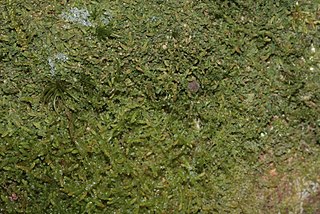
Jamesoniella is a genus of liverworts in the family Adelanthaceae.

Butomus is the only known genus in the plant family Butomaceae, native to Europe and Asia. It is considered invasive in some parts of the United States.

Hypericum canariense is a species of flowering plant in the family Hypericaceae known by the common name Canary Islands St. John's wort. It is the sole member of Hypericumsect. Webbia.

Triantha is a small genus of flowering plants in the family Tofieldiaceae, first described as a genus in 1879. False asphodel is a common name for plants in this genus.

Sagittaria rigida, the sessilefruit arrowhead or Canadian arrowhead, is an aquatic plant species native to Canada and to the United States and also naturalized in Great Britain. It grows in shallow waters along the edges of ponds and streams. What is really interesting is that it has narrow oval leaves rather than the iconic arrowhead shaped leaves of species like the Sagittaria latifolia. it has sessile female flowers, which is where it gets its name from. Its flowers are very similar to other plants in the Sagittaria family, with three white petals. It grows "potato" like tubers which can be eaten. Gathering any tubers from the Sagittaria family can be dangerous if gathered from polluted water.
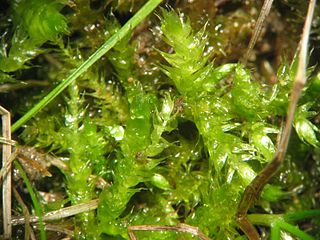
Brachytheciaceae is a family of mosses from the order Hypnales. The family includes over 40 genera and 250 species.

Arenga westerhoutii is a single-stemmed, evergreen palm found in tropical rainforest. It grows up to 12 meters tall and is one of the largest species in the genus Arenga. The unbranched stem is about 40cms in diameter. The palm has ornamental value. It is distributed in Bangladesh, India (Assam), Cambodia, East Himalaya, Laos, Malaya, Myanmar, and Thailand.

Kindbergia is a genus of mosses belonging to the family Brachytheciaceae.

Syntrichia latifolia, formerly Tortula latifolia, and commonly known as water screw-moss, is a species of moss belonging to the family Pottiaceae. Syntrichia species differ from members of Tortula due to synapomorphic leaf qualities, such as different basal and distal cells, as well as different costal cross sections where Tortula has an abaxial epidermis and Syntrichia lacks one.
Hypnum is a genus of mosses belonging to the family Hypnaceae.
Bryocrumia vivicolor is a rheophytic species of moss belonging to the family Hypnaceae, and is the sole representative of the genus Bryocrumia.
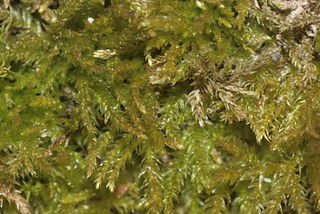
Eurhynchiastrum pulchellum is a species of mosses belonging to the family Brachytheciaceae. It is the sole species of the genus Eurhynchiastrum.
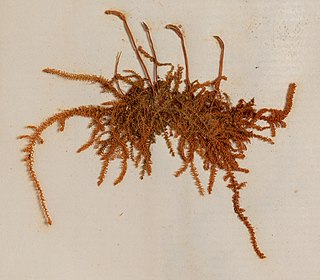
Racopilum is a genus of mosses belonging to the family Racopilaceae.
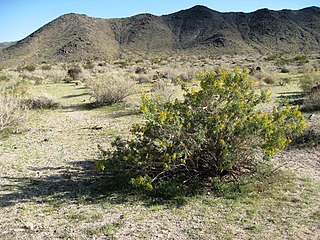
Peritoma was a genus in the plant family Cleomaceae with six species of shrubs and annuals, but is now considered synonymous with Cleomella. All six species are native to North America, concentrated mostly in southern California, and with large populations in the rest of the western United States and northwestern Mexico. The name "Peritoma" is derived from the Ancient Greek words "peri" (περί), meaning "about" or "around," and "toma" or "tome" (τομή), meaning "cut." The name "cut-around" refers to the calyx that splits around its middle as the fruit dehisces.
Luisierella is a genus of mosses belonging to the family Timmiellaceae.
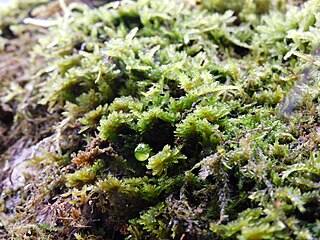
Leptodontaceae is a family of mosses belonging to the order Hypnales. There are 3 genera with a worldwide distribution.
















